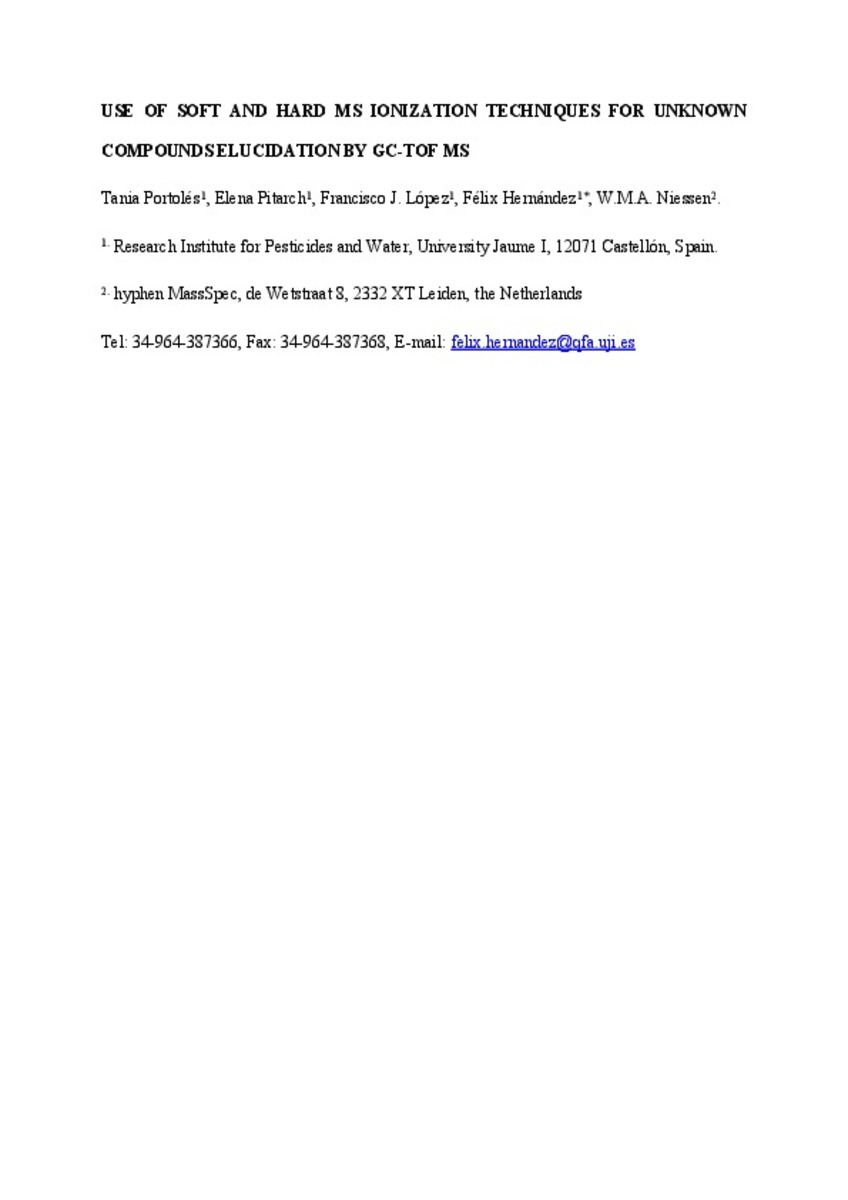| dc.contributor.author | Portoles, Tania | |
| dc.contributor.author | Pitarch, Elena | |
| dc.contributor.author | Lopez, Francisco | |
| dc.contributor.author | Hernandez, Felix | |
| dc.contributor.author | Niessen, Wilfried M. A. | |
| dc.date.accessioned | 2012-05-30T10:39:00Z | |
| dc.date.available | 2012-05-30T10:39:00Z | |
| dc.date.issued | 2011-05-11 | |
| dc.identifier.citation | Rapid communications mass spectrometry (11 May 2011), vol. 25, no. 11, 1589-1599 | ca_CA |
| dc.identifier.issn | 0951-4198 | |
| dc.identifier.issn | 1097-0231 | |
| dc.identifier.uri | http://hdl.handle.net/10234/39280 | |
| dc.description.abstract | Investigation of trace-level non-target compounds by gas chromatography/mass spectrometry (GC/MS) often is a challenging task that requires powerful software tools to detect the unknown components, to obtain the deconvoluted mass spectra, and to interpret the data if no acceptable library match is obtained. In this paper, the complementary use of electron ionization (EI) and chemical ionization (CI) is investigated in combination with GC/time-of-flight (TOF) MS for the elucidation of organic non-target (micro)contaminants in water samples. Based on accurate mass measurement of the molecular and fragment ions from the TOF MS, empirical formulae were calculated. Isotopic patterns, carbon number prediction filter and nitrogen rule were used to reduce the number of possible formulae. The candidate formulae were searched in databases to find possible chemical structures. Selection from possible structure candidates was achieved using information on substructures and observed neutral losses derived from the fragment ions. Four typical examples (bifenazate, boscalid, epoxiconazole, and fenhexamid) are used to illustrate the methodology applied and the various difficulties encountered in this process. Our results indicate that elucidation of unknowns cannot be achieved by following a standardized procedure, as both expertise and creativity are necessary in the process | ca_CA |
| dc.format.extent | 27 | ca_CA |
| dc.format.mimetype | application/pdf | ca_CA |
| dc.language.iso | eng | ca_CA |
| dc.publisher | John Wiley | ca_CA |
| dc.relation.isFormatOf | Pre-print del document publicat a: http://onlinelibrary.wiley.com/doi/10.1002/rcm.5028/abstract | ca_CA |
| dc.rights | © 2011 John Wiley | ca_CA |
| dc.rights.uri | http://rightsstatements.org/vocab/InC/1.0/ | * |
| dc.subject | Soft and hard ionization techniques | ca_CA |
| dc.subject | Elucidation of unknown compounds | ca_CA |
| dc.subject | Gas chromatography | ca_CA |
| dc.subject | Time-of-flight | ca_CA |
| dc.subject | Mass spectrometry | ca_CA |
| dc.subject.lcsh | Mass spectrometry | ca_CA |
| dc.subject.lcsh | Gas chromatography | ca_CA |
| dc.subject.other | Espectrometria de masses | ca_CA |
| dc.subject.other | Cromatografia de gasos | ca_CA |
| dc.title | Use of soft and hard ionization techniques for elucidation of unknown compounds by gas chromatography/time-of-flight mass spectrometry | ca_CA |
| dc.title.alternative | Use of soft and hard MS ionization techniques for unknown compounds elucidation by GC | ca_CA |
| dc.type | info:eu-repo/semantics/article | ca_CA |
| dc.identifier.doi | http://dx.doi.org/10.1002/rcm.5028 | |
| dc.rights.accessRights | info:eu-repo/semantics/openAccess | ca_CA |
| dc.type.version | info:eu-repo/semantics/submittedVersion | |







